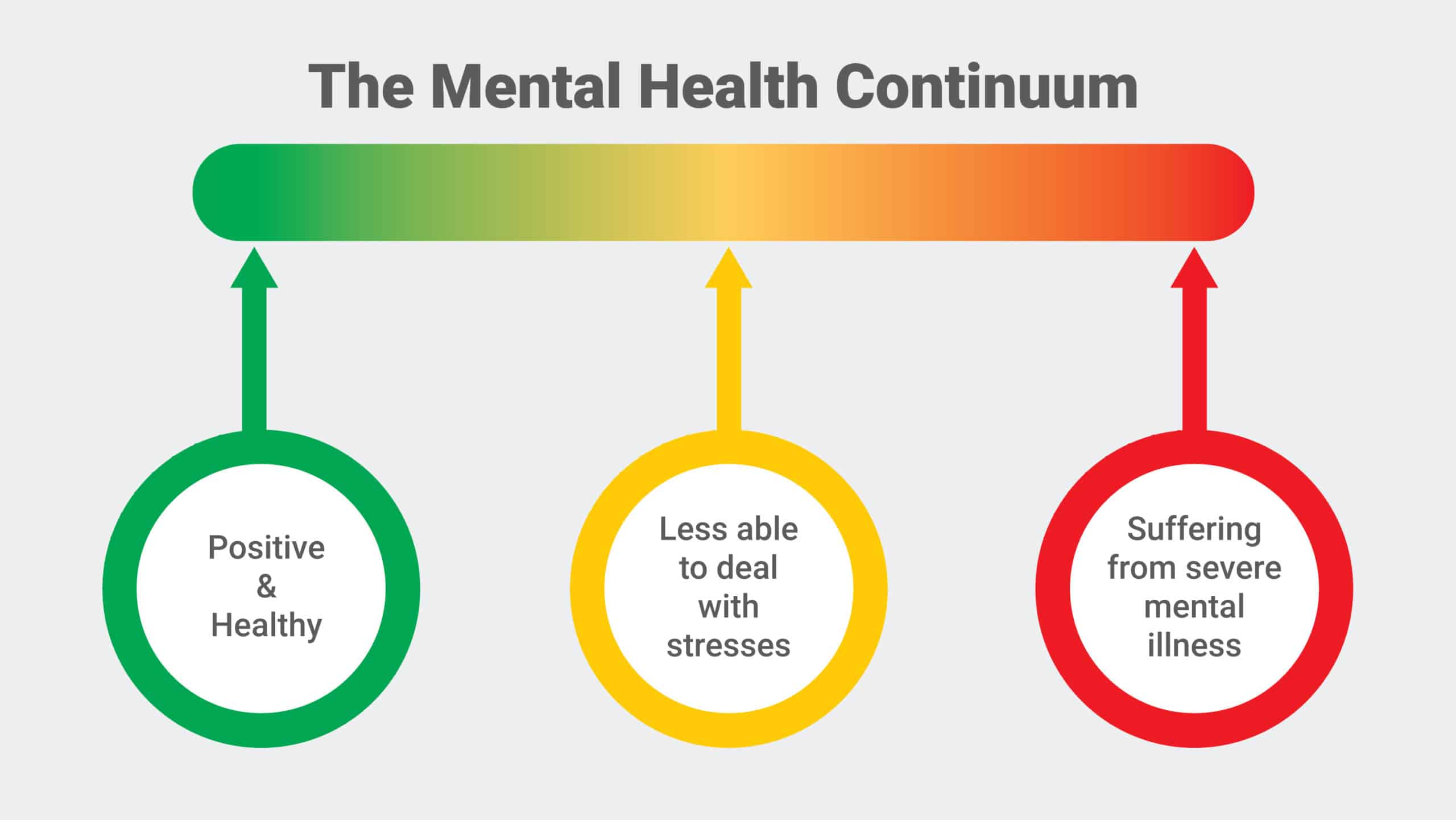
Our mental health is not fixed. It is fluid – always moving. Take a moment and think about it. Some days you feel like you are on top of the world but on other days, you don’t want to see the world and just want to close the blinds and stay under the covers. Our mental health can drift from one state to another, and this is normal.
The Mental Health Continuum is a tool developed to help us understand this changing nature of mental health. Seeing mental health as a spectrum is essential as it allows us to be more forgiving of ourselves and others, as well as understand when it is time to seek help.
What Is the Mental Health Continuum?
Simply put, it is a scale which represents the spectrum of mental health. On the very far left of the spectrum is perfect mental health, while on the very far right is mental illness that severely restricts our ability to function. In reality, very few people exist at the extreme ends of the continuum.
The majority of us sit somewhere between the two ends. But it’s important to understand that we also don’t stay in the same place on the continuum. Our mental health might drift towards the right or left, depending on a myriad of factors.
Our movement depends on many things, like how we deal with pressure or stressful life events such as moving home, losing a loved one or the responsibility that comes with a high-powered job.
Mental health practitioners use the mental health continuum to understand our mental health and to spot when mental health can start to transition to mental illness.
The Mental Health Continuum Model
There are different mental health continuum models, ranging from the simple to those that are more in-depth.
Let’s take this simple model below.

To the left, in green is where we would like to be, feeling positive and functioning healthily. And to the right in red is where severe mental illness is causing us distress. There are also different types of mental ill health along the continuum.
Let’s throw two characters into the mix – Henry and Douglas.
Henry gets lots of exercise, sleep and eats healthily. He is happy and positive about life and gets along well with his colleagues. He works hard, and really enjoys his job. When difficulties and stresses do come up he feels in control and copes well.
Douglas, on the other hand, struggles with feelings of anxiety. It affects his sleep and he often feels worn down. He’s a bit of a loner, hates exercise and is the first to admit that he doesn’t eat well. Life feels like a struggle to Douglas.
It’s obvious where these two sit on the mental health continuum. But as we said, mental health is fluid.
Let’s suppose Henry experiences a difficult life changing event that hits him hard. He doesn’t feel like exercising, his sleep is badly affected, and he starts to withdraw from social events.
At the same time, Douglas gets some mental health therapy. He learns to cope better with his feelings of anxiety and starts to lead a healthier lifestyle. All of a sudden, things look very different.
The point is that we all need to be self-aware. Nobody knows our minds better than we do, so we need to pay attention to where we sit, most of the time, on this spectrum. Human minds are always moving but we have the potential to drive ourselves towards the left of this continuum. But how? By building your mental resilience.
What Is Mental Health Resilience and How Is It Built?
Imagine your mental health is a wheel travelling on a road. Your mental resilience can be thought of as the strength of that wheel. As you travel along the road of life, sometimes it can be smooth and easy. You feel good. But when you hit a rough patch, which does happen from time to time, your mental resilience will be tested.
The stronger your wheel, the better you will cope. Mental resilience is all about building a stronger wheel.
Your wheel is made of many spokes, the most important are:
- Sleep – which profoundly affects mental health
- Exercise
- Diet
- Social support – relationships
Lastly, the way in which you manage your thoughts to keep things in perspective is often referred to as mindfulness. Having a healthy dose of all of these elements contributes to positive mental wellbeing and builds up resilience for those challenging times.
What About Mental Health at Work?
If you find yourself struggling with mental health at work there are a number of things that you can do. Check your company intranet pages to explore what resources are available for employees. Many companies have Employee Assistance Programs (EAP) where employees can get free, confidential counselling sessions with qualified therapists.
Employers are also training up employees to be mental health first aiders. Their role is to spot the early signs when someone is struggling mentally, and to assist with guiding them to get appropriate help. Their training includes how to deal with mental health emergencies like colleagues experiencing psychosis, having suicidal thoughts, or attempting suicide. The training helps improve the mental health of the employees. Furthermore, it highlights employers’ commitment to cultivating a supportive and empathetic work environment that prioritises the mental well-being of the workforce.
Where to Go for More Information
There is a wealth of resources on mental health. The great thing is that you can choose how you wish to receive the information and when. From listening to a podcast while out for a walk or watching a Ted Talk on YouTube.
The Human Focus website also has range of courses and information that you can take advantage of. If you are short on time there are courses such as the CPD certified Mind Management Skills course that you can complete in 30 minutes. Got longer? Why not check out the Mental Health First Aid Training course which runs for 8 hours.
Taking Action When Its Needed
What the mental health continuum shows us is that our mental wellbeing can vary as we go through life. Depending on what is happening to and around us, our thoughts and feelings can shift, and that’s completely normal. It is important that when things start to get too much, we seek help, in the hope of preventing a long-term impact that can push us to an extreme.
About the author(s)

Beverly Coleman



























































































































































































































































































































































































































































































































































































































































